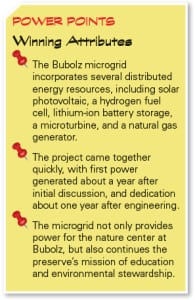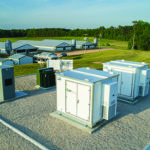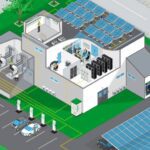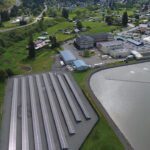Providing power for a nature preserve required not just progressive technology, but also the innovative approach needed to embrace the facility’s educational and environmental missions.
Interest in ensuring reliable power, and controlling energy costs, has led to a rise in distributed power generation. A variety of technologies are available to generate electricity at or near where it will be used, including solar panels, wind turbines, combined heat and power systems, and emergency backup generators fueled by natural gas, gasoline, or diesel.
Advances in microgrid technology have allowed more facilities to generate their own power, which is either islanded or connected to the larger grid. Industrial complexes, military bases, college campuses, and other facilities are taking advantage of the value of generating their own electricity, along with the resilience it offers.
Many projects are worthy of recognition for POWER magazine’s first Distributed Energy Award, in advance of POWER’s inaugural Distributed Energy Conference in Golden, Colorado, in October. Our editors chose one (Figure 1) that combines several technologies, including solar, a fuel cell, microturbine, battery storage system, and natural gas generator. The project takes advantage of cloud-connected, software-as-a-service (SaaS) optimization, allowing the system to create different permutations to increase the efficiency of the energy resources available at any given time.
This microgrid, which recently began service at the Gordon Bubolz Nature Preserve in Appleton, Wisconsin, was developed by Menasha, Wisconsin-based Faith Technologies in partnership with global energy and automation provider Schneider Electric. It provides power at a 725-acre site that has operated for more than 45 years in Wisconsin’s Fox Valley, where the preserve provides educational programs, recreational spaces, and conservation ethics. The microgrid is monitored remotely, feeding live performance data to Faith Technologies’ Innovation Center in Menasha.
Several DERs at Work
The mixture of technologies (Figure 2) in the Bubolz microgrid presents an overview of distributed generation and distributed energy resources (DERs). The microgrid includes a 200-kW solar photovoltaic system; a 30-kW hydrogen fuel cell; a 100-kW lithium-ion battery storage system with Panasonic technology; a 65-kW microturbine; and a 60-kW natural gas generator. The microgrid powers buildings on the campus, including the preserve’s 18,000-square-foot environmental center, built by Faith in partnership with The Boldt Company. The building opened to the public in January of this year.
“First and foremost, we wanted to redefine what was possible with on-site energy generation,” Charlie Fredrickson, vice president of investments for Faith Technologies, told POWER. “That was the crux behind the development of this microgrid.” The nature center provided “a place for Faith Technologies and Schneider Electric to do some R&D [research and development] work to demonstrate how efficiently these technologies work in concert with one another, while supporting the nature preserve’s mission of environmental sustainability.”
The microgrid’s integrated DERs are managed by Schneider Electric’s Energy Control Center, a pre-engineered power control center which works in conjunction with Schneider Electric’s EcoStruxure Microgrid Advisor, a cloud-connected energy management SaaS platform. According to the companies, “The tool can autonomously configure the DERs into a range of different permutations to produce the most efficient, clean, and cost-effective combination of energy resources available at any given time. Energy pricing and resource availability can change minute by minute, so this modular, scalable, repeatable microgrid technology will help the Gordon Bubolz Nature Preserve unlock better financial sustainability.”
“I think that it’s going to become a showcase for the Midwest. Our EcoStruxure Microgrid Advisor is really the brains of the project,” Don Wingate, vice president Strategic Customers and Microgrid Solutions for Schneider Electric, told POWER. “We really value the relationship we have with Faith Technologies. Schneider Electric’s advanced technology is included in the microgrid, and it’s great having someone like Faith who has made an investment in what we believe is really a unique presentation of a microgrid solution. It’s a showcase of many different use cases of microgrid technology. They’ve created an environment that can blend lots of generation sources together. It provides future users an educational tool to see how there’s more to energy than just turning the lights on. It’s sustainable, cost-efficient, and really shows the concept of a prosumer that can produce energy as well as consume energy and help the environment.”
“This microgrid was designed and engineered by Faith’s team of energy experts and utilizes specialized equipment and technology made possible through our collaboration with a very forward-thinking partner: Schneider Electric,” said Mike Jansen, Faith Technologies’ CEO. “We worked together to make sure we were creating a solution that was not only environmentally smart but enhanced the preserve’s organizational sustainability through cost-effective energy efficiency as well.”
Fredrickson said the project came together relatively quickly. “We came up with the idea in January–February 2017,” Fredrickson said. “We had our first design meeting with Schneider in June [2017] and we needed to have the microgrid functioning, creating some level of power, by January 2018.” That goal was accomplished by prebuilding components in a shipping container, placing it on-site, and constructing the building around it.
Fredrickson said the Bubolz microgrid incorporates “DERs based on different customer needs,” noting it uses natural gas, solar, and storage, along with the hydrogen fuel cell. “It demonstrates how [multiple] resources can work together to create a microgrid. We selected typical DERs that our customers have expressed interest in as well as renewable energy resources to demonstrate how a microgrid operates disconnected from the grid.”
He continued: “Getting the various vendor components to work in concert with each other was probably the biggest technical challenge. We were fully functional and operating disconnected from the grid by May of this year, less than one year from full engineering to completion.”
Many Benefits of Microgrids
The U.S. Environmental Protection Agency (EPA) says there are more than 12 million distributed generation units, including microgrids, in use across the country. The EPA notes that the systems provide a variety of benefits, including emissions reductions along with resiliency and energy security. Their use has been highlighted over the past few years in the wake of devastating storms and other natural disasters as a way to more quickly restore power to affected areas.
Microgrids not only can provide backup power in case of emergencies but also can be used to help operators control energy costs. Microgrids help communities and facilities be more energy independent and, as the EPA notes, often more environmentally friendly.
“From a broad market perspective, all the events of the past year, in Houston, Florida, Puerto Rico, shows how the whole industry is being disrupted, how the business models of regulated utilities are being disrupted, and in a good way,” Wingate said. “Microgrid technology is really becoming a better way [to produce power].”
Wingate said, “When you produce energy closer to the source, it’s more efficient and more reliable, and that’s what microgrid technology is all about. We’re very excited about [the Bubolz project]. It’s one more example of how it’s doable, it’s cost-effective, and how it’s helping to change the industry.”
“A microgrid allows business owners to control one of the top expenses they face today: energy costs,” Jansen said. “This microgrid at Bubolz was designed to showcase the wide range of clean energy components that can make up a microgrid. From solar panels to microturbines, we’re able to customize an energy solution that is tailored to each individual business. Microgrids provide control, in the form of uninterrupted clean energy, to today’s energy-reliant businesses.”
The use of energy storage in the Bubolz project is part of an increasing trend in power generation, according to energy analysts, including Joseph Coscia, a commercial energy analyst for business consultancy ICF. “Historically the vast majority of energy storage in the U.S. consists of pumped hydro systems. In recent years, focus has shifted to batteries [especially lithium-ion],” Coscia told POWER. “These systems have several advantages, including the ability to be deployed in a variety of size/duration configurations, operational flexibility to perform multiple services for the grid, fast development times compared to conventional power projects, and rapidly declining costs in recent years.”
Connected to the Cloud
Integration of a high-tech microgrid controller enables the Bubolz system to manage its power production and consumption, helping control its energy costs while increasing its sustainability, efficiency, and resilience. With cloud-connected software, the system can become more sophisticated without on-site visits or physical changes from either Schneider Electric or Faith, as the companies can monitor the microgrid assets and update the system’s programming remotely.
The Bubolz microgrid will act as a testing site for such increasingly sophisticated microgrid operations, allowing for testing and measurement of the technology in a real-world setting while supporting the nature preserve and its educational and environmental missions.
“We have customers interested in microgrids and wanting to learn more about how their business can benefit from the reliability and sustainability of this technology,” Fredrickson said. “So, for them to be able to see one [like Bubolz] functioning is important. We have customers ready to implement, maybe not a system with this number of DERs, but more typical configurations.”
The company is working with Schneider Electric again on a project that will serve Faith’s customers and employees. “We have a Faith Technologies ranch in western Kansas,” Fredrickson said. “It’s a retreat center for customers and employees. Since the development of our microgrid at Bubolz, we have now developed in partnership with Schneider Electric a small container microgrid unit for the ranch.”
Fredrickson said that unit will have solar panels, battery storage, and a fuel cell “that runs on methanol mixture. We will ship it to the site and it will power that facility.” Before being sent to the ranch, the unit will be displayed in the innovations area at the Experimental Aircraft Association center in Oshkosh, Wisconsin. ■
—Darrell Proctor is a POWER senior associate editor.













